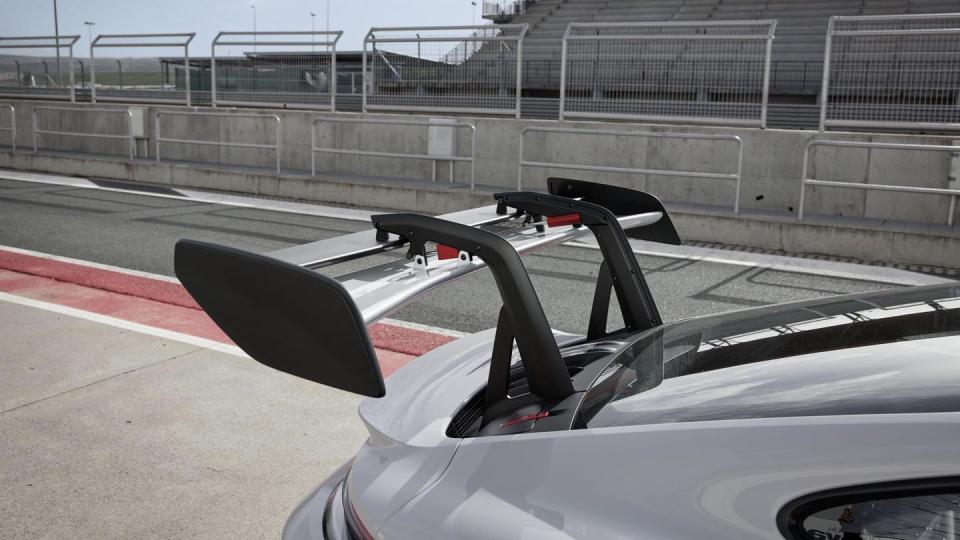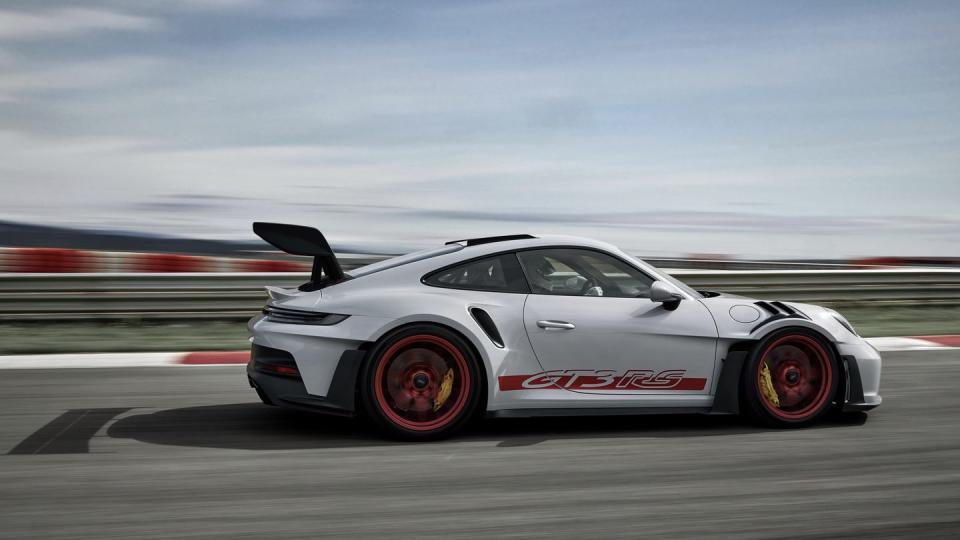The 2023 Porsche 911 GT3 RS Is a High-Downforce Track Monster

How do you improve on one of the best track cars in the world? Give it a load more downforce, apparently. That's the approach Porsche's taken with the new GT3 RS, and the result looks like what would happen if you crossed a 911 with a McLaren Senna.
We're at a fascinating point now where the aerodynamics of this 911 street car are more advanced than the GT3 R race car. Most prominent is a new bi-plane rear wing that uses swan neck mounts like we've seen on the GT3 and Cayman GT4 RS, but on the GT3 RS, the wing is active. Actuators on the mounts can change the top plane's angle of attack, cutting drag or increasing downforce as needed. The wing section can even act as an airbrake. Porsche says the car generates over 900 pounds of downforce at 124 mph and and astonishing 1895 pounds at 177 mph. Porsche says this is twice as much as the last GT3 RS and three times as much as the current GT3.

The fender vents above the front wheels that have been a mainstay since the 991.1 GT3 RS make a return appearance here, helping vent pressure in the wheel wells. In a first for a 911, there's no front trunk. That space has been taken up by a large radiator that vents through huge openings on the hood. Ditching the 911 GT3's triple radiator setup allowed Porsche to add active front wing elements, to help balance out what's happening at the rear.
The engine breathes in part through intakes ahead of the rear wheels that look like those from the current 911 Turbo. It's the familiar "GT3" unit, a 9000-rpm 4.0-liter flat-six that first appeared in the 991.2 GT3, and since the 991 Speedster has benefitted from individual throttle bodies. Output is 518 hp, up 16 hp from the GT3 thanks to new camshafts with longer duration. That's not a huge step beyond the previous GT3 RS, which speaks to both how close this engine is operating to its maximum output and the fact that Porsche was more focused on chassis and aerodynamics for this car. The engine didn't need changing anyhow—it's one of the all-time great internal-combustion mills. As with all Porsche RS models, the engine is mated to a seven-speed PDK.
Also adapted from the GT3 is a new double-wishbone front suspension setup inspired by the modern 911 GT3 R that provides astounding front-end grip and increased steering precision. Interestingly, the upper wishbones are designed to help increase downforce to the tune of 88 pounds, says Porsche.
Quite astonishingly, compression and rebound settings for the GT3 RS's adaptive dampers can be adjusted by the four knobs attached to the steering wheel. The knobs can also be used to change differential and traction/stability control settings—there are seven TC settings alone—as well as the familiar drive mode setting. There's also a button to activate the drag-reduction system.
Thanks to the use of lots of carbon fiber and other composite materials, the GT3 RS weighs just 3268 pounds, far lighter than something like a Mercedes-AMG GT Black Series. Even the doors are made from carbon-fiber, and they ditch the regular 992's flush-mounted handles. A Weissach Package is also available and adds visual carbon-fiber body pieces, carbon-fiber-reinforced-plastic (CFRP) anti-roll bars and end links, and a CFRP shear panel for the rear subframe. Forged magnesium wheels also come standard with the Weissach Pack.

Porsche isn't yet sharing a Nürburgring lap time for the new GT3 RS, yet we expect it to be substantially quicker than the last GT3 RS, which ran a 6:56.4, and the current GT3, which can do a 6:55.2.
We do know the price—$225,250 when it arrives at dealers next Spring. A hell of a lot of money, and yet, any customer will feel like a hero if they get one at sticker, such is the hype around these cars.
You Might Also Like

